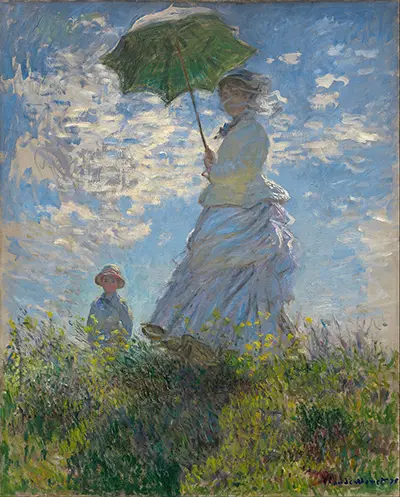Argenteuil is only just a fifteen-minute train journey from France's capital, Paris, which made it all the more of an ideal getaway for anyone living nearby who were looking for a break from city life. Even by the middle of the 1800s, when factories were flooding the town, it still provided a picturesque landscape and a relaxed setting to feel at peace in. The town of Argenteuil was the place where impressionist painters could envision their inspiration. In Woman with a Parasol, it shows exactly that a woman with a parasol, a green parasol, and a child. Argenteuil was famed for its places where families could enjoy walks, and this is what Monet painted in Woman with a Parasol.
The focus of the painting is on the figure in the centre, Monet's wife Camille. She stands dead centre on the top of a hill, and the blue sky behind her as the backdrop. The woman is dressed in a white dress that has twirled because it has blown in the wind. Monet often experimented with colour and light, and this can be seen clearly by the way he has coloured the woman's dress.
Some parts are quite light, where as other parts of the dress are darker. This could be because the sun is behind her. Further down the hill from the woman is a boy, his waist only visible, and his legs are hidden tall strands of grass, and yellow flowers that have grown there.
The painting is a representation of Monet's impressionist style that he presented in many of his other pieces of art work during the period, and he did this in the perfect setting of Argenteuil. The work Monet produced was something that hadn't been seen before him. The contrast of a town and a holiday resort, which was full of new and rising industry was the sort of place that attracted these types of artists. Long before impressionism, Academies were where the rules about what art would be displayed and celebrated would be determined, and not just that but they also decided what art the artists should be painting. Those artists were Monet, Renoir, and Sisley, as well as other impressionist artists formed themselves into an artists group. Pierre-Auguste Renoir was only 21 when he entered the art academy. He wanted to make a career as a painter and so he worked hard towards being exhibited at the Paris salon, as it was the place every artist wanted to be. Though he struggled to afford paint and to pay the bills, he decided to paint decorations on blinds, fans and signs for money.
He soon became friends with other like minded artists and students, Claude Monet and Alfred Sisley. Little did they know that they would one day become renowned for their art. Once Monet was able to get away from the constraints of the Academies, it meant that he could finally paint something like Woman with a Parasol, something from the heart as it shows his family on an afternoon walk. As the figures in the picture are looking towards the viewer, the view that Monet took when he first painted the picture. We see what he saw and by conparision it is as if they have been there the entire time without interruption on their quiet stroll through nature, but they have taken a momentary pause to glance toward Monet.
It is interesting to think why they that, and was it a natural accurrence or perhaps Monet asked them to look towards him for a brief moment. This spontaneity was a clever convention by Monet and used it again in his other works. He chose to paint his family in their everyday life and with Monet's application of quick brushstrokes it gives the painting a real sense that the event in the picture happened in real time. Among Claude Monet's best-known works, other than Woman with a Parasol are, A Walk in the Estate, The Ice Floes, Flowers in Fruit, Lane in Normandy, Farmyard in Normandy, Impression Sunrise, as well as many more. There is something truly unique and inspiring about Monet's paintings as they transport the viewer into a different time and place.


